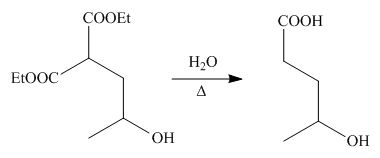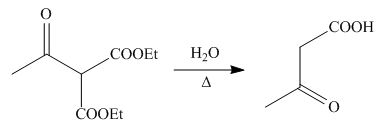
Concept explainers
(a)
Interpretation: The products formed by the reaction of
Concept introduction: Nucleophilic addition reaction is a type of organic reaction in which the nucleophile is added to the electrophilic site. The carbon atom in carbonyl compound acts as an electrophilic centre where a nucleophile attacks and gives an addition product.
Answer to Problem 23.47P
The product formed by the reaction of
Explanation of Solution
The given compound is,

Figure 1
The nucleophile

Figure 2
On the further treatment of

Figure 3
Hence, the product formed by the reaction of
The product formed by the reaction of
(b)
Interpretation: The products formed by the reaction of
Concept introduction: Nucleophilic addition reaction is a type of organic reaction in which the nucleophile is added to the electrophilic site. The carbon atom in carbonyl compound acts as an electrophilic centre where a nucleophile attacks and gives an addition product.
Answer to Problem 23.47P
The product formed by the reaction of
Explanation of Solution
The given compound is,

Figure 4
The nucleophile

Figure 5
On the further treatment of

Figure 6
Hence, the product formed by the reaction of
The product formed by the reaction of
(c)
Interpretation: The products formed by the reaction of
Concept introduction: Nucleophilic addition reaction is a type of organic reaction in which the nucleophile is added to the electrophilic site. The carbon atom in carbonyl compound acts as an electrophilic centre where a nucleophile attacks and gives an addition product.
Answer to Problem 23.47P
The product formed by the reaction of
Explanation of Solution
The given compound is,

Figure 7
The nucleophile

Figure 8
On the further treatment of

Figure 9
Hence, the product formed by the reaction of
The product formed by the reaction of
(d)
Interpretation: The product formed by the reaction of
Concept introduction: Nucleophilic addition reaction is a type of organic reaction in which the nucleophile is added to the electrophilic site. The carbon atom in carbonyl compound acts as an electrophilic centre where a nucleophile attacks and gives an addition product.
Answer to Problem 23.47P
The products formed by the reaction of
Explanation of Solution
The given compound is,

Figure 10
The nucleophile

Figure 11
On the further treatment of

Figure 12
Hence, the products formed by the reaction of
The products formed by the reaction of
Want to see more full solutions like this?
Chapter 23 Solutions
Organic Chemistry
- As we have seen in this chapter, carbon-carbon double bonds are electron-rich regions that are attacked by electrophiles (e.g., HBr); they are not attacked by nucleophiles (e.g., diethylamine). However, when the carbon-carbon double bond has a carbonyl group adjacent to it, the double bond reacts readily with nucleophiles by nucleophilic addition (Section 19.8). Account for the fact that nucleophiles add to a carbon-carbon double bond adjacent to a carbonyl group and account for the regiochemistry of the reaction.arrow_forwardFill in the missing reagents a-e in the following scheme:arrow_forwardWhat is the reagent in this reaction? a. mCPBA, water, H+ b. H2, Pd c. NaBH4, water d. KMNO4arrow_forward
- What product is obtained from the reaction of excess benzene with isobutyl chloride + AlCl3 ?arrow_forwardChemistry Draw the product formed when phenylacetaldehyde (C6H5CH2CHO) is treated with reach reagent: f. (CH3)2CHNH2, mild acid g. (CH3CH2)2NH, mild acid h. CH3CH2OH (excess), H+ i. piperidine, mild acid j. HOCH2CH2OH, H+arrow_forwardWhat would be the reagent for each step?arrow_forward
- The synthesis of carbohydrates can be particularly difficult because of the large number of chiral centers and OH functional groups present. Epoxides can be useful synthetic intermediates in carbohydrate syntheses. Draw the product of the following reaction of a Gilman reagent with each epoxidearrow_forwardThe reduction of butanal with NaBH₄ forms what product?arrow_forward
 Organic ChemistryChemistryISBN:9781305580350Author:William H. Brown, Brent L. Iverson, Eric Anslyn, Christopher S. FootePublisher:Cengage Learning
Organic ChemistryChemistryISBN:9781305580350Author:William H. Brown, Brent L. Iverson, Eric Anslyn, Christopher S. FootePublisher:Cengage Learning

